I underestimated Mini once and I promised myself I would never let that happen again. A few years back I tested the the Mini Cooper S Convertible in Los Angeles. Despite my initial misgivings I ended up really enjoying my time in the car, far more than I expected. You would think that after that experience, I wouldn’t dare prejudge a Mini with 306 horsepower and a sport suspension. You’d be wrong.
Fast forward to a recent trip to Frankfurt, Germany, and I once again found myself behind the wheel of a Mini. This time it was the updated, range-topping (for now) John Cooper Works Clubman. But despite my vow to keep an open mind, I found myself wondering why the powers that be at Mini would bestow this little wagon with so much power, when the smaller Cooper might’ve been a better choice.
I mean, in my mind, the Clubman is a crossover in everything but height. It’s got six doors! Six! How can you make a vehicle with six doors sporty?
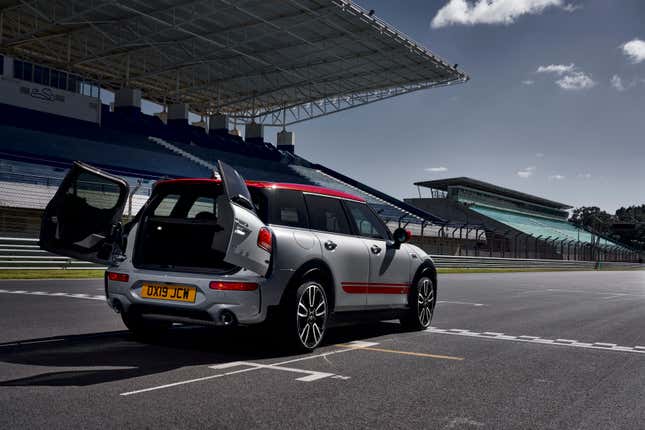
Apparently the folks at Mini figured it out, because the Clubman JCW is the very embodiment of sporty.
(Full Disclosure: Mini wanted me to drive the Clubman JCW so bad that they flew me to Germany during its hottest week ever, in a country that has a pathological aversion to air conditioning. Then made up for it by taking me to many some beer gardens. Fair trade, I think.)
Preconceived Notions
So let’s examine the basis for my mistake in judging the Clubman.
In my mind, the Clubman was primarily a utility vehicle—a small wagon, not an SUV, but a people-mover first. In pictures its long wheelbase, box-on-box design and split rear doors make it seem quite big, almost like Mini’s actual crossover, the Countryman.
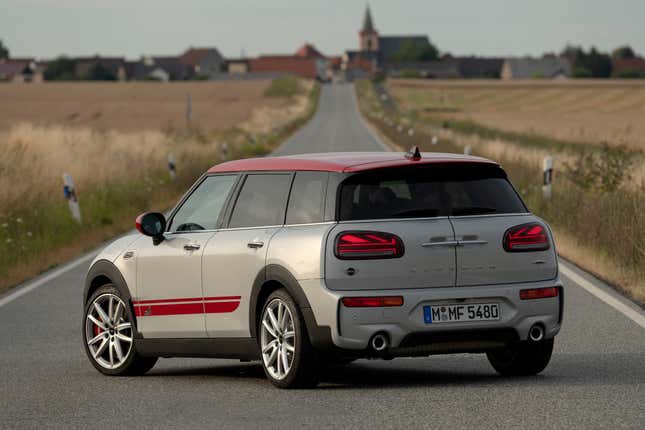
Only after seeing the car in person do you realize how small it really is. For scale, the Clubman is actually the same size (if not a tick smaller) as a Volkswagen Golf. The styling and proportions of the Clubman combine to make the car seem much larger than it really is.
The really interesting stuff comes when you get inside. With its high roofline and more upright design, interior space is what I would conservatively call cavernous. By comparison, I daily’d a Ford Focus RS for a few years and at 6’1” the Focus feels positively claustrophobic compared to the Mini. Don’t even get me started on the Fiesta or the 500. I’m still nursing a bad back and a mild concussion after spending a week driving the tiny Abarth through Italy. The “inside is larger than the outside” thing is a neat trick and this Mini pulls it off masterfully.
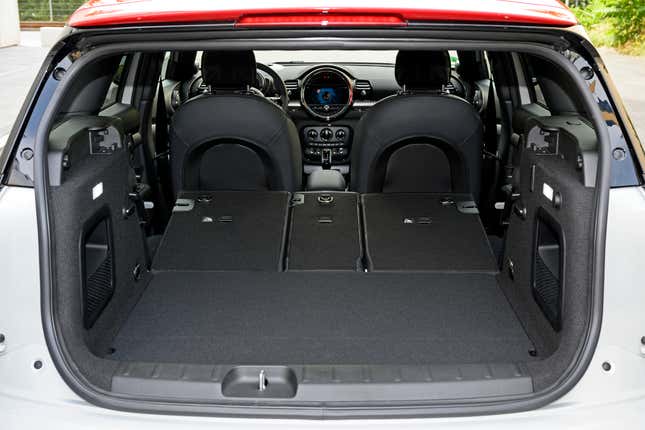
Speaking of space, with the rear seats folded down the Mini will pack 44 cubic feet of your stuff in back (12.7 cubic feet with the seats up). Additionally the Clubman’s quirky rear split doors make accessing all of that space a breeze.
Staying with the topic of the interior for a bit, Mini has made done some modest restyling inside. Don’t worry, it’s nothing too drastic. Mini’s quirky styling still remains if you like that sort of thing. The oversized circular center infotainment center stack is still there, as is the circular instrument cluster. Both come with some mild refreshing.
Powering Up
But enough about size. John Cooper Works variants are supposed to be all about performance, right? So how does the JCW treatment work on the medium-sized Clubman?
Well, first I suppose I should tell you what the JCW treatment is on the new Clubman.
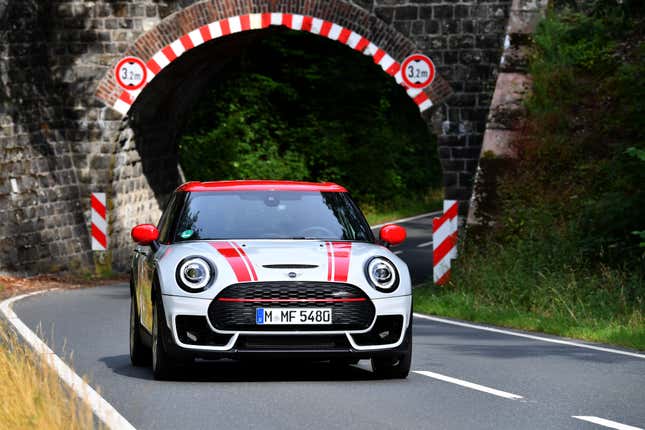
The JCW Clubman has been around for a few years now, and it’s received mixed reviews around the Jalopnik office. But for 2020 it gets the kind of power boost that, if you own the old one, will probably make you throw your hat on the ground and start jumping on it like some Looney Tunes character. The 2.0-liter turbocharged inline-four now produces 306 horsepower and 331 lb-ft of torque. It is the most powerful engine ever fitted to a Mini.
This is a substantial increase over last year’s model. It represents a bump of 73 HP and 74 lb-ft of torque. The gains were achieved by fitting a bigger turbo pushing more boost with less compression, new higher-flowing injectors, and upgraded pistons and connecting rods. As the engineers at Mini figured a few of these might actually make their way on to the track, they’ve also equipped the JCW with better cooling as well.
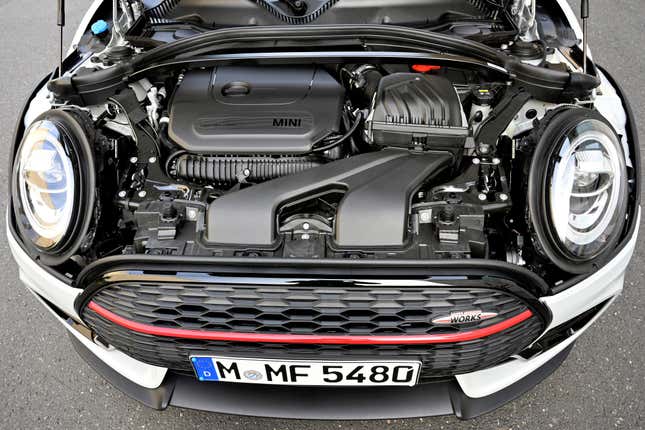
The JCW’s powerplant is mated to an eight-speed automatic transmission, which in turn feeds Mini’s ALL4 all-wheel drive system. AWD and a slushbox is all you get here; sadly, the manual option on the JCW Clubman is gone, which fits with similar moves by BMW as of late.
The AWD setup is a front-biased system that will send up to 50 percent of the available power to the rear wheels when required. On the plus side, the system is fitted with an honest-to-goodness mechanical locking differential. No E-diff here.

With that much power and grip available the Clubman JCW can now do a claimed zero to 62 mph (100 km/h) in just 4.7 seconds, with an electronically limited top speed of 155 mph. That represents a huge jump in quickness over the old Clubman JCW—a Car and Driver test of the latter in manual form put that car at 6.7 seconds. For reference, the Golf R is a tenth slower to 100 km/h, and the vaunted Civic Type R is almost a full second slower. This is now a very quick breadvan.
Other Upgrades
Next on the list of upgrades is the suspension. New components specific to the JCW have improved vehicle dynamics and additionally have allowed Mini to dial in a bit more front camber. The performance shocks are tuned to JCW specs too. Two-mode adaptive dampers are optional. And four-piston calipers, front and rear, grip massive brake discs (360 × 30 millimeters front and 330 × 20 millimeters rear). The calipers are painted red with the JCW logo gracing the fronts.

Just to make sure you’re paying attention, that’s 306 HP, AWD, with performance suspension and brakes, in a package that is basically as fast as the Golf R and has an even more practical rear door setup. See where I’m going here?
On paper, it’s obviously impressive. But to find out how it actually performs, I set out on some awesome, narrow B-roads that snake through the countryside surrounding Frankfurt.
On The Road
Now, Germans take their roads very seriously. They are constantly maintaining and upgrading them to such a degree that they would challenge most any race track in the U.S. for drivability. And on these roads the JCW Clubman shone. The stiffer suspension combined with Mini’s traditionally tight handling and small package made attacking corners effortless.
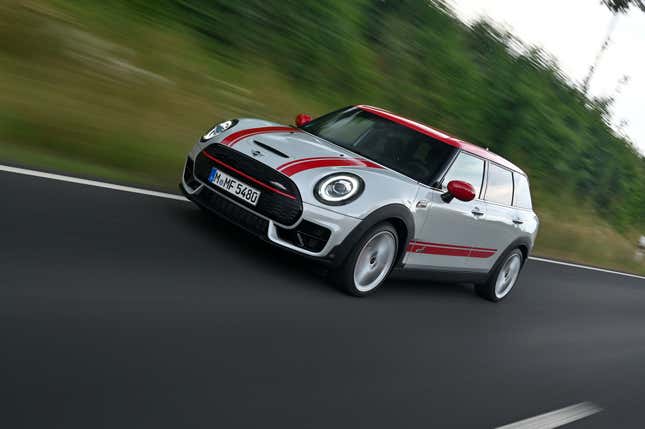
One of the characteristics that I look for in a car is my ability to place the front wheels exactly where I want them. Most hot hatch street cars are a bit vague when it comes to this. I can get them to within a couple of inches either way most of the time, but it’s a bit hit or miss. Not so with this Mini. Here I was able to hit my marks every. Single. Time.
Add in a wide power band—peak torque is available from 1,750 RPM all the way to 4,500—AWD to get that power down and its diminutive size to navigate the narrow roads, and the Mini starts feeling a hell of a lot less like a family hauler to me and way more like the hot hatch performer that it is.
Making our way out to the Autobahn we managed to find a few unrestricted speed sections. Of course, after weeks of record high temperatures, the German version of Mother Nature decided to pick that moment to open up the heavens and hit us with a downpour. No matter, that just gave me an excuse to see how good the AWD system on the JCW was.
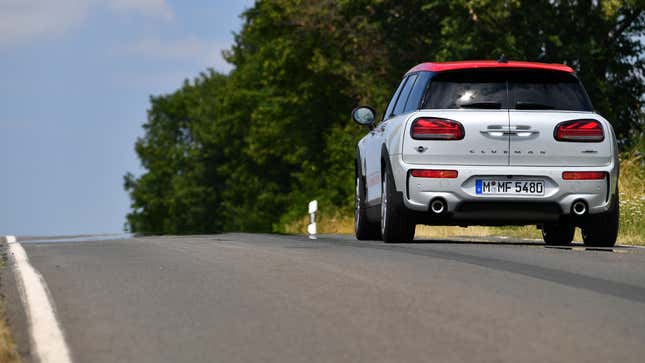
Verdict? An indicated 260 km/h (that’s 161 mph) and still pulling hard when I had to back off for traffic in the rain. It may be a small car, but it’s no econobox. Clearly the ALL4 system in the Mini works well, and keeps the car totally stable even in low-grip situations. Note the speed we hit was several miles per hour faster than the 155 mph top speed that the car is supposed to be limited to. So our press testers hadn’t been limited that way, or the speedo was a bit off. Either way the JCW Clubman proved its Autobahn chops to me.
So what’s the downside to all this performance? Some of it is the traditional JCW weakness, and I’d add a problem endemic to most modern M cars too: That super-stiff suspension can be a pain unless the road you’re on happens to be perfect. It was so good on the smooth B roads, but less good once we made our way back into the city. The rougher roads there definitely exposed the higher spring and damper compression rates that Mini used to squeeze out every last bit of that performance. Not to say that the ride was harsh, but it was definitely on the firmer side—noticeably so. Although I wasn’t able to test them, I think those who live in areas with less groomed roads might want to opt for the adaptive suspension.
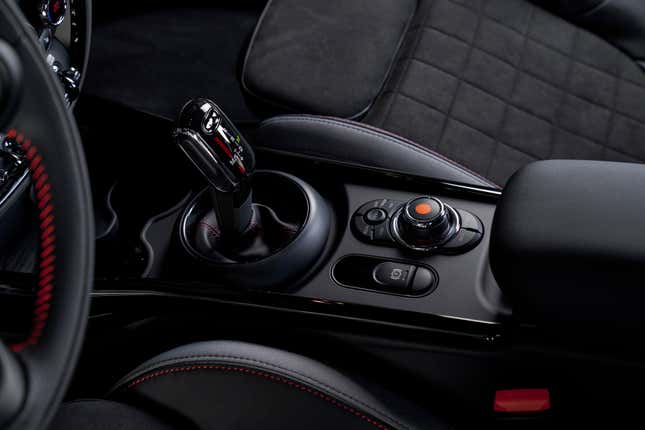
A few other small issues popped up. The chief one is that throttle tip-in, when not in Sport mode, is not as responsive as it should be. What I mean by that is that when you are looking to accelerate away from a stop in the Normal driving mode, the first half an inch or so of throttle travel is pretty sluggish. That means you have to be more aggressive on the throttle which then launches you off the line far quicker than you might have liked. I caught several raised eyebrows from the locals as I inadvertently launched F1 style from a stop sign. I’ve been told by Mini execs that that our press fleet were preproduction models and that this issue will be fixed before the cars hit dealer lots.
Better Tech, Too
Mini made more big improvements is actually by robbing parent company BMW’s infotainment parts bin.
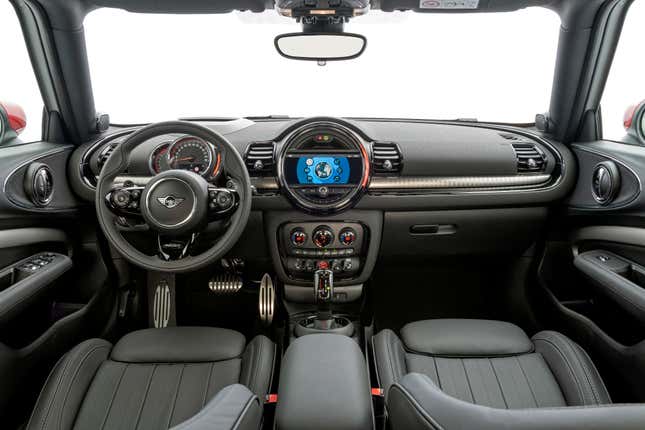
The Clubman’s new infotainment system is, to my experience, almost identical to the one in the new BMW 3 Series, which I drove earlier in the week. This is a good thing, as it’s a feature-packed yet incredibly accessible system.
As someone who jumps in and out of new cars almost on a weekly basis, one of my big gripes is trying to sort out how to use the infotainment system on the fly. Systems from some manufacturers are insanely difficult to figure out even the most basic of functions. If I’m grinding my teeth after five minutes trying to figure out how to sync my phone in a car, I don’t even want to think about living with it for a half-dozen years.
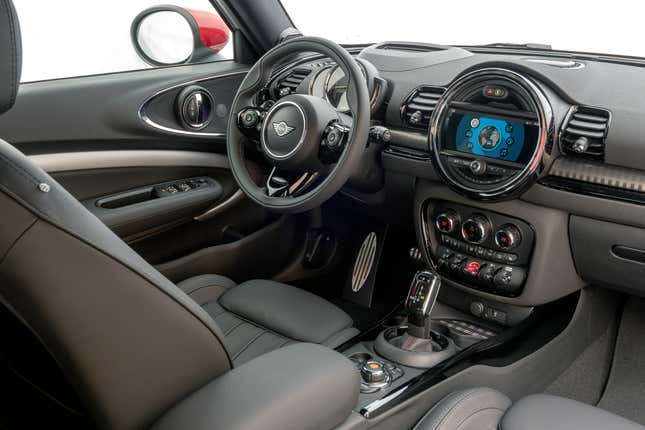
With the Mini system fired up, I was able to sync my iPhone in a matter of seconds and it re-synced without issue, every time I got back in. Additionally one of the features I really liked was that if you lightly put your finger (without pressing) on any of the numbered buttons lining the screen, a drop-down menu would tell you exactly what the function of that button was in whatever function screen you were currently in. Contextual menus! Imagine that.
Infotainment operating systems are becoming a primary consideration for new car buyers and it’s nice to see manufacturers finally catching up with the times.
Early Verdict
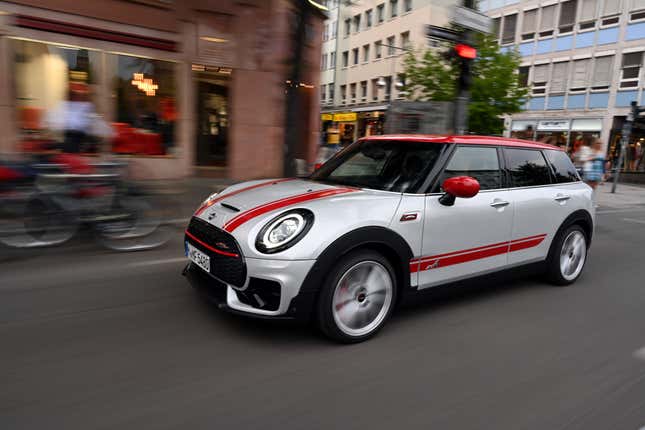
I started off going into this review wanting to compare the Mini to other “fun” small cars like the Fiat 500, Fiesta ST or the Citroën Cactus. You know, cars that have a following because they are fun, quirky and small. Mini’s John Cooper Works Clubman is definitely that but it also is so much more. It is now a legitimate hot hatch performance car that should also be looked at up against other serious performance cars like the VW Golf R ($40,120) and the Civic Type R ($36,300).
The JCW Clubman starts at $39,400, a $3,000 bump over the 2019 model, but that still puts it in range with its direct competitors. Just keep in mind that upper trims and options tend to make these more expensive, but it’s a solid value overall.
Right now the John Cooper Works Clubman is the top of the performance heap in Mini’s lineup. But for those of you who think stomping all over a Golf R still isn’t enough, Mini is launching the even more hardcore John Cooper Works GP edition later this year. Same engine in an even lighter, smaller front-wheel-drive platform.
For me at least, it’s an excuse to try and get back to Germany, this time a bit north and west of Frankfurt. I know a pretty cool track up that way.
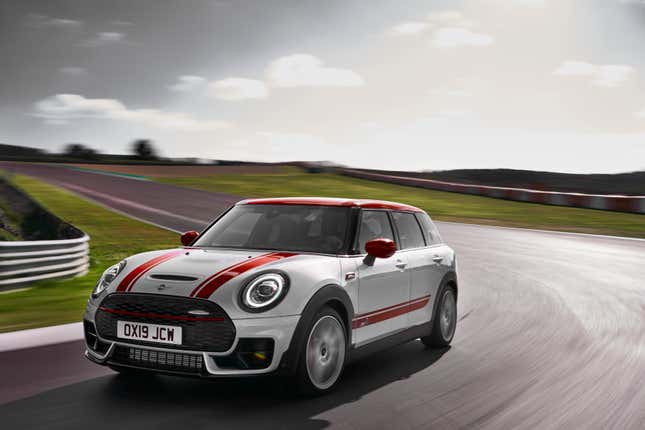
Correction: This story has been updated to include correct 2020 model year pricing.
